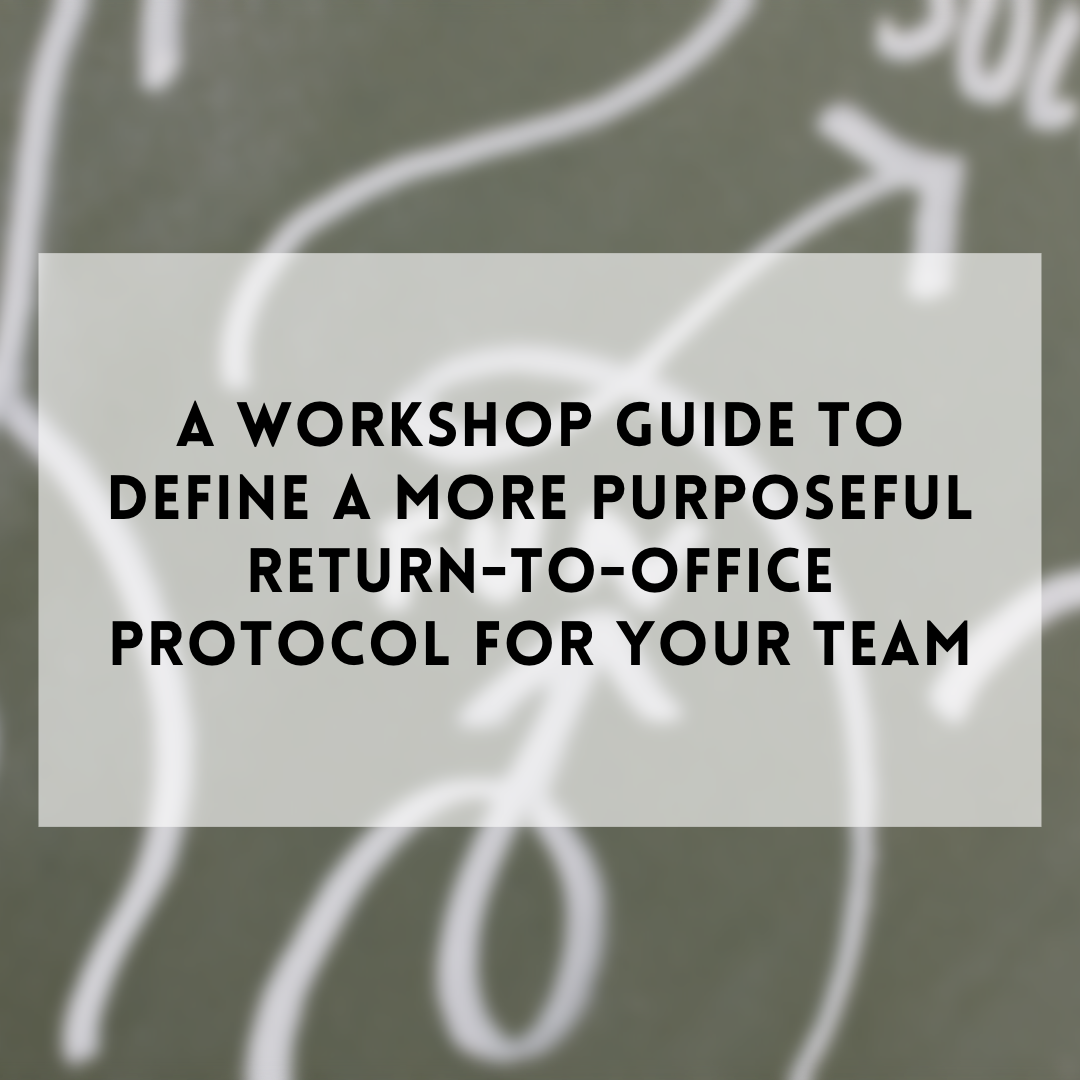A workshop guide to define a more purposeful return-to-office protocol for your team
The return-to-office conversation has been top of mind for many as more and more companies call employees back to work in person.
There’s a lot of chatter around how often, when, and whether it should be required or not.
But are those really the right questions? Instead of “when” and “where,” shouldn’t we be asking why we want to get together, and how to gather with purpose?
I’ve heard so much “rationale” for in-person presence that seems to be mostly based on logistics and control rather than what’s best for the people and the work at hand. Stories of people returning to the office and feeling even more isolated because the days they’re in aren’t even coordinated with their colleagues’, or because they end up sitting alone in a conference room attending virtual meetings all day anyway.
Is that really what we want?
Rather than simply telling people to return to the office without any structure or intention, let’s instead think about the best way to accomplish the work to be done.
We can start by asking ourselves questions like:
What work will benefit from collaboration?
Which interactions are important to have in person? Which aren’t?
What’s the best format for gathering? (e.g. if we have a distributed team, maybe it doesn’t make sense to require anyone to be in an office, but it does make sense to have the team gather quarterly for a 2-day collaboration session.)
Remember the mantra, “no purpose, no meeting”?
I think this can and should be extended to the broader landscape now that we’re all trying to figure out where to be during our work days, and how to be together in new ways.
Why try to force people back into the old model where work was a place we went to? Instead, let’s look at the ways we can support people, embrace flexibility, and maintain boundaries.
Let’s let people define the meeting and gathering formats that work best for their teams and their work, and empower people within organizations to co-design their approaches to working together (which is exactly what the workshop guide enclosed at the end of this article seeks to do).
This requires us to think about the purpose and intent of being in a physical space together. It asks us to be deliberate about virtual gatherings and meeting norms, and the tools that support getting work done outside of those shared moments.
This worked well with a recent client, who I helped define a team operating model following some big strategic planning sessions.
First, we specified owners for the work that had been outlined, as well as ways for leaders to collaborate and make progress collectively, and with their teams. This meant thinking about the reasons why team members would come together, and how often.
Then, we defined meeting cadence and purpose, which included creating structured agendas and a process for documentation and communication between meetings to help encourage continuity for the whole team.
Creating an intentional plan gives purpose and structure to in-person time. It capitalizes on the moments that matter most for the team to be in the office, and releases those that don’t.
It’s not necessarily the “fun” or “sexy” part of getting work done, but it’s the necessary glue that can make or break whether a team feels connected and purposeful — or the opposite.
Ready to try this “at home”? Here’s a workshop format for team leaders and managers who want to handle this next chapter with intention.
The Intentional Return-to-Office Workshop Guide
Who should run the session: team leads, managers, or a dedicated facilitator
How: invite your teams to co-design the way of working with you!
Where: in person (a perfect example of when to meet in person)
What to do:
Think about the work to be done: Identify the types of work the team handles, then determine which work will benefit from in-person collaboration.
Determine when collaboration should happen. Is it a one-time event or project, or do we need to build regular touchpoints into our way of working?
Think about the team: Is everyone located in geographic proximity to one another, or distributed throughout the country or the world? This should absolutely be an input to the frequency of in-person time.
Design the approach for collaboration time: Is it a one-time workshop agenda, or a quarterly gathering where you have an outline of what you intend to cover each quarter?
Determine the frequency of in-person vs virtual meetings based on the above.
Identify what needs to be true for collaboration to occur beyond the time together: This shouldn’t be all that different from defining the tools and channels that were used pre-pandemic, but if things are getting lost or missed because you’ve got a hybrid team or fewer water-cooler moments, define the ways that documentation and communication can occur to support keeping momentum going.
Rather than asking teams to return to office just because “it’s what we’ve always done,” why not take this time as an opportunity to reinvent the ways we meet? When we take an intentional approach to gathering, we make the notion of in-person time – and what we’re able to accomplish during that time – so much more powerful.
Interested in more articles like this? Check out this recent post about how we might lead and work in ways that are more supportive of being human (rather than as human-productivity machines).
